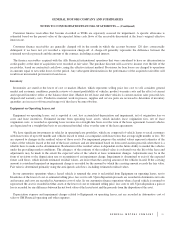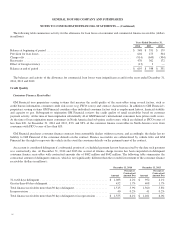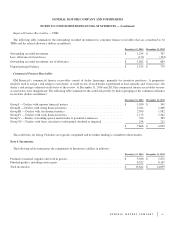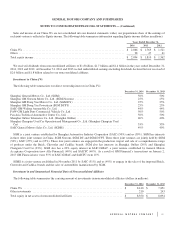General Motors 2014 Annual Report Download - page 79
Download and view the complete annual report
Please find page 79 of the 2014 General Motors annual report below. You can navigate through the pages in the report by either clicking on the pages listed below, or by using the keyword search tool below to find specific information within the annual report.
GENERAL MOTORS COMPANY AND SUBSIDIARIES
NOTES TO CONSOLIDATED FINANCIAL STATEMENTS — (Continued)
adjustment at the balance sheet date. In determining whether an adjustment to the external valuation is required, we will review
material factors that could affect the valuation, such as changes to the composition or performance of the underlying investments or
comparable investments, overall market conditions, expected sale prices for private investments which are probable of being sold in
the short-term and other economic factors that may possibly have a favorable or unfavorable effect on the reported external valuation.
Derivatives
Exchange traded derivatives, such as options and futures, for which market quotations are readily available, are valued at the last
reported sale price or official closing price on the primary market or exchange on which they are traded and are classified in Level 1.
Over-the-counter derivatives, including but not limited to swaps, swaptions and forwards, which are typically valued through
independent pricing services with observable inputs are generally classified in Level 2. Swaps that are cleared by clearinghouses or
exchanges are valued with the prices provided by those venues and are generally classified in Level 2. Derivatives classified in Level
3 are typically valued via the use of pricing models which incorporate significant unobservable inputs. The inputs part of the model
based valuations may include extrapolated or model-derived assumptions such as volatilities, yield and credit spread assumptions.
Job Security Programs and Extended Disability Benefits
We have job security programs to provide UAW and Unifor (combined union of the Canadian Auto Workers union and the
Communications, Energy and Paperworkers Union of Canada) employees reduced wages and continued coverage under certain
employee benefit programs depending on the employee’s classification as well as the number of years of service that the employee
has accrued. We also provide extended disability benefits for employees currently disabled and those in the active workforce who may
become disabled in the form of income replacement, healthcare costs and life insurance premiums.
We recognize a liability for job security programs and extended disability benefits over the expected service period using
measurement provisions similar to those used to measure our OPEB obligations based on our best estimate of the probable liability at
the measurement date. We record actuarial gains and losses immediately in earnings.
Stock Incentive Plans
We measure and record compensation expense for all share-based payment awards based on the award’s estimated fair value which
is the fair value of our common stock on the date of grant for Restricted Stock Units (RSUs) and Performance Share Units (PSUs).
For awards that do not have an accounting grant date established, the compensation cost is based on the fair value of our common
stock at the end of each reporting period. We record compensation cost for the awards on a straight-line basis over the entire vesting
period, or for retirement eligible employees over the requisite service period. Salary stock awards granted are fully vested and
nonforfeitable upon grant; therefore, compensation cost is recorded on the date of grant. The liability for stock incentive plan awards
settled in cash is remeasured to fair value at the end of each reporting period.
Policy, Product Warranty and Recall Campaigns
The estimated costs related to policy and product warranties are accrued at the time products are sold and are charged to
Automotive cost of sales. These estimates are established using historical information on the nature, frequency and average cost of
claims of each vehicle line or each model year of the vehicle line and assumptions about future activity and events. Revisions are
made when necessary based on changes in these factors. The estimated costs related to recall campaigns are accrued at the time of
vehicle sale in GMNA and when probable and reasonably estimable in other geographical regions.
Income Taxes
The liability method is used in accounting for income taxes. Deferred tax assets and liabilities are recorded for temporary
differences between the tax basis of assets and liabilities and their reported amounts in the consolidated financial statements using the
79
























